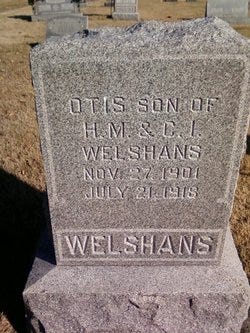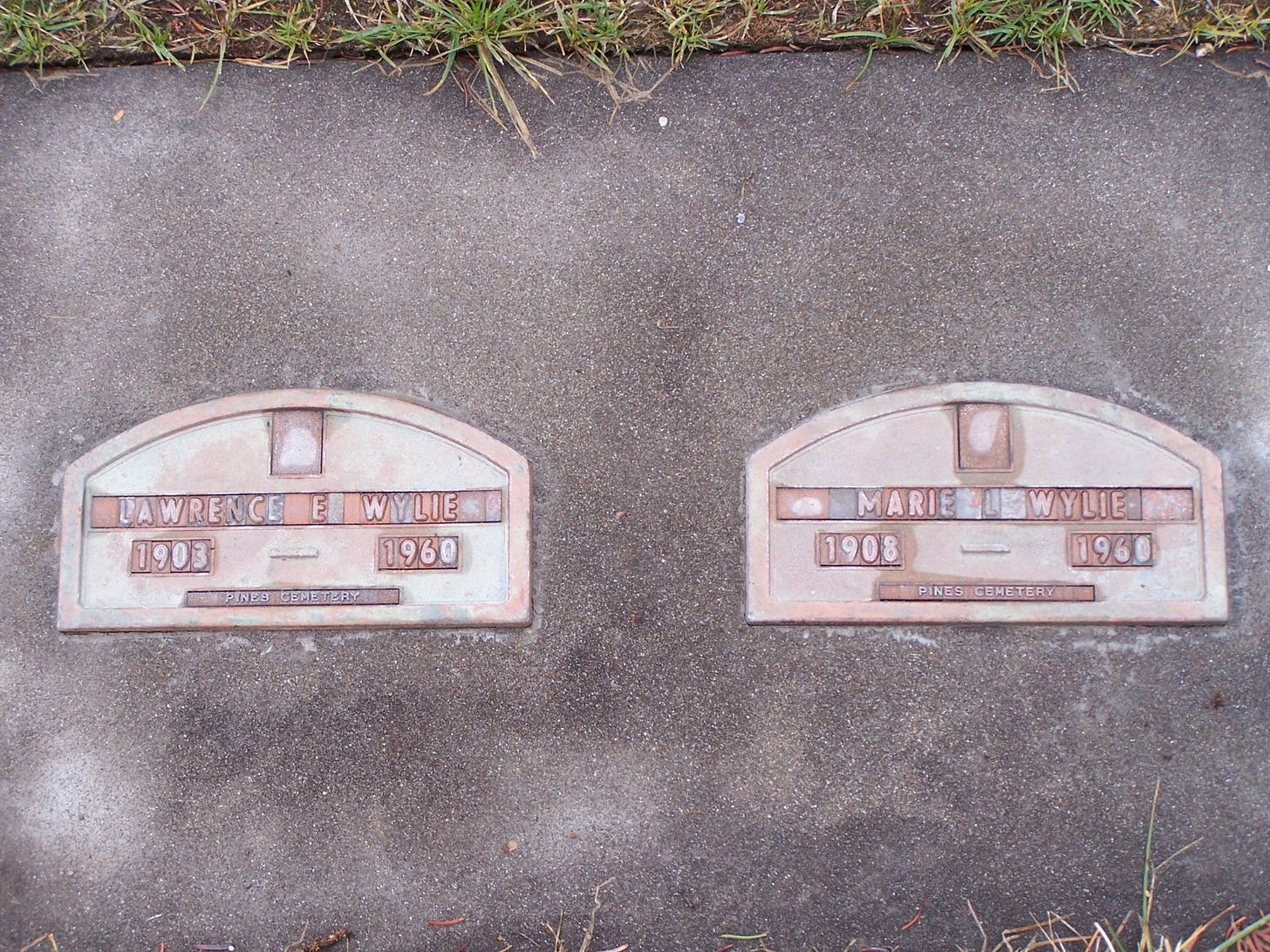Saturday night murder
The night of his murder, (In one version) Otis Welshans had worked at Hood’s grocery store until 10 PM. Charles Otis Lehnherr and Lawrence Wylie met him in front of Eiker’s (furniture store on Broadway) sometime later and called him to go with them to get an iron pipe near the Auditorium on Jackson Street. By 12:15 AM, July 21, 1918, Otis Welshans was dead, “his head terribly crushed.”
The newspaper summed up the life of Otis Welshans as “…the deceased was rated a good boy.” A distant cousin descended from the Wylie family had heard her grandmother say that Welshans was “simple.” Others had favorable comments about Otis, painting the picture of a trusting and simple boy. Otis was my grandmother’s favorite nephew.
The photo
In archaeology, "provenience" is the term to describe the spatial and contextual information needed to interpret an artifact’s significance. A related word “provenance” is often heard on Antiques Roadshow and refers to the documented history of ownership or custody of an object (like a piece of art). Fresh from my Introduction to Archaeology class in 1974, I put my grandmother to work writing names on back of old photos.
She kept a drawer full of loose photos with no organization whatsoever, so this struck me as a good place to start. I gave no instructions other than write on the back who the people in the photos were. In hindsight, I could have added, what, where, when, and why in addition to the who.
Grandma sat dutifully at her task as we went through the photos one by one. She seemed pensive, avoiding a deep sadness. There were things unspoken, too painful to write on the back of the photos. But not fully recognizing this at the time, I let her off easy. We finished the task and the photos went back in the drawer, forgotten again.
Seven years later, Mary Minerva Welshans Shaw died and the photos found their way into the care of my father and later eventually to me. Fifty years from that afternoon of writing names on the back of photos, I am still trying to figure out the what, where, when, and why. This is the story of one of those photos, a tale of murder and pain for an entire community.
Some years later, while reviewing the photo collection, I rediscovered the sparse words, “Otis Welshans, Henry’s son” on the back of one. Otis was the son of my grandmother’s brother. My genealogy software informed me that Otis is my first cousin once removed although it seems impossible that someone gone so long could be that closely related. I added the name and photo to my expanding family tree but I did not yet know the story.
The story is discovered
About four years ago while sitting in the Chester Library scrolling through spools of microfilm, I stumbled on to the whole story. I was looking for something else of course. Genealogy works that way. You always find the best stuff while looking for something else. Serengenity1 strikes again!
Sixteen year old Otis was murdered by his friends for the $22 in his pocket. The local newspapers carried the story on the front page. It was the sad result of four boys prowling the streets on a Saturday night after midnight.
The local newspaper headline screamed:2 3
Murder Most Atrocious.
Otis Welshans, Aged 16, Victim of Premeditated Murder for The Wages He Drew Saturday Night - - - Laurance [sic] Wylie and Otis Lehnherr the Prisoners Charged With The Crime
It was a terrible crime and committed by boys so young in years, for a paltry sum of money. It is no wonder the Spartans are astonished and humiliated beyond measure. We give our sympathy for the parents and pity and censure for the boys.
The lifeless body of Otis Welshans was spotted by a freight conductor from the vantage point of his train coming through town early Sunday morning. The 1967 image below shows the actual depot building nearby to the scene of the murder. In a strange coincidence of art imitating life, the movie In the Heat of the Night, was filmed in Sparta, Illinois.
Actor Sidney Poitier was opposed to making the movie in the deep south due to racial tensions at the time. The movie presents itself set in Sparta, Mississippi but the film crew decided that Sparta, Illinois looked enough like the sleepy southern town they needed for the production design. Ironically, the movie plot line also involves the found body of a man killed by a blow to the head. The train depot still stands in good condition. If you visit Sparta, Illinois you can easily find it down by the tracks. And if you happen to watch the movie, you’ll see much of the town used as an outdoor set.

Using 1910 Sanborn insurance maps and newspaper descriptions, I believe the murder occurred south of the auditorium mentioned in records.4 In the map below, the auditorium is in yellow in the upper left corner. The estimated location of the murder scene would then be near the small structures south of the auditorium also indicated in yellow. In the photo above, looking toward the east northeast the crime scene would be just past the water tower in the far background seen behind actor Rod Steiger.
In an alternate telling of events by Charles Lehnherr, seemingly at odds with the earlier description, gives the exact location of the murder as:5
Lehnherr said he met Wylie and Welshans in front of Eiker’s store, went to Lessleys, then to M & O Depot, then south to place of killing …into the Burns junkyard.
The newspaper account seems to have confused south with east. But in any case, the boys appeared to have gone to the depot and talked to the ticket agent, then doubled back east to Burns junkyard and the site of the killing. The GPS coordinates would be approximately 38°07'15.6"N 89°42'17.0"W.

Aftermath
The very next day after the body was discovered, Otis Welshans was laid to rest at Union Cemetery where the funeral was well attended. Fifteen year old Lawrence Wylie (sometimes spelled Wiley) pled guilty and was sentenced to 25 years at Menard Prison conveniently located in Chester, the next town over. His father, John S. Wylie was said to have stated, “You did a man’s crime, you can do a man’s time.” In a surprise ending, Emil Steinkraus, age twenty, originally thought innocent was considered to be the ringleader and found guilty after a heated two day trial. Steinkraus was sentenced to 40 years at Menard also. The corroborating testimony of his two accomplices convinced the jury of Steinkraus’s guilt, indicating that Steinkraus had delivered the fatal blow with a rock.
Charles O. Lehnherr, the allegedly passive accomplice was later sentenced to reform school rather than prison in recognition of the fact that he did not actually strike any blows to Welshans nor did he accept any of the blood money.

The oral history from the Wylie family relates a dramatic narrative that Lawrence Wylie saved the life of a prison guard during a riot at Menard Penitentiary thereby earning an early release provided he leave town. After release from prison Wylie relocated first to S. Dakota where he learned the piano trade with his brother. He later moved to Spokane, Washington where he married, raised a family and created a successful piano company. By all accounts, he seemed to be a respected and beloved member of his community. He died in 1960 at his home just a few months after the death of his wife at age 57.
At the time of Welshans murder in 1918, Wylie had been kicked out of his home by his disagreeable stepmother. He resorted to sleeping in the family’s livery stable, or at his grandmother’s house. Awash in family trauma including the death of his mother and remarriage of his father Lawrence Wylie was roughly pushed out on his own before his 16th birthday. His world was in free fall.

Charles O. Lehnherr later confessed to helping plan the murder of Welshans and was sentenced to an indeterminate period of incarceration at the Reform School in St. Charles, Illinois. Sometime before 1927 he moved away to Brookfield, a small town near Kansas City, Missouri, where he married and raised a family. He is shown in the 1940 census as proprietor of a welding shop. Eventually the marriage ended in divorce and he is found living in an apartment alone by 1950. Charles Otis Lehnherr died in 1981 at the age of 79.

Lehnherr’s home life was abnormal as he was the youngest child of six, born to older parents already ages 67 and 59 at the time of the murder. He was described as slight and as an adult in 1948 returning home from Guam, was listed on the flight manifest as weighing only 118 pounds.
Emil Steinkraus was found in the 1920 census working as a machinist helper while incarcerated at Menard Penitentiary in Chester, Illinois. Described at the time of the murder thusly: “He ran away from home many years ago and has always been incorrigible.” By February 2019, it was reported that “Steinkraus is charged with having done the killing.”6 It was later reported that his sentence was reduced to 25 years in “the Reformatory.” Later still, he took his case on appeal to the Illinois Supreme Court and apparently won his freedom on technicalities. One descendant of the Wylie family today is of the opinion, Steinkraus won his freedom only because he had “gotten to” Wylie and Lehnherr who suddenly became reluctant to testify against him during the appellate case.
After his release Steinkraus went to Washington County, Missouri where he married a woman from that remote area.7 This terrain more closely resembles mountainous Western landscape than it does the farming Midwest and is the sort of place rough men go to hide out. Did he fear reprisal for killing Otis Welshans? Ten years later after the ‘29 crash he moved his wife and children back to Belleville, Illinois, area of his birthplace. Steinkraus died in 1994 in Arkansas at the age of 95.

What Remains
It is not difficult to see what happened in the case of these three boys and one young man. Each was missing a vital part, whether it be a dead mother, an absent father or an unexplained emptiness driving a young man onto the street. The urge to replace a male role model led three boys to follow a twenty year old leader. And much like William Golding showed us in Lord of the Flies,8 an aggressive boy directs weaker boys and those weak boys find an even weaker boy to release their violence on to. The story ends on a hot summer night with a town weeping for the loss of innocence and the darkness lurking within us all.
Serengenity is a portmanteau of serendipity and genealogy.
“Local newspaper clipping, July 1918,” in possession of the author.
Murder Most Atrocious seems to be a variation on Shakespeare’s Murder Most Foul from Hamlet. It was a favorite word of the Chester Herald Newspaper editor, having been used numerous times between 1914 and 1922 to describe variously; farming conditions, Lizzie Borden, tornados, and the Welshans murder.
The site of the old Auditorium and bowling alley is roughly where the state DMV is now located on W. Jackson St.
“Local newspaper clipping, July 1918,” in possession of the author.
"The Belleville News-Democrat," Belleville News-Democrat, February 4, 1919, 5, Newspapers.com.
The Concord township area of Washington County, Missouri is one of the most remote and rugged areas of Missouri. There is little industry and much of the county is set aside as Wilderness area. It would be an ideal location for someone to “hide out.”
Golding, William. Lord of the Flies. New York: Penguin Books, 1954.






Thank you Mary Minerva Welshans & David Shaw. I knew my grandfather's brother was murdered at/near a train station, but did not where or why. I now know why no one ever talked about it. Your article is the only picture I have seen of him.
This is heartbreaking. It had to be crushing for his mother who came so close to having her son with her. Per Google maps, if it is correct, it looks like the old depot has been spruced up and, at the time of the image, is Misselhorn Art Gallery. I'm glad the building is being cared for.